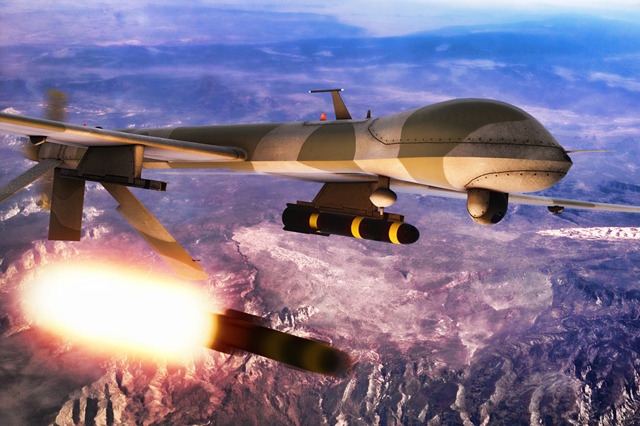Weaponized drones are the new gunpowder. Low cost unmanned aerial vehicles are are changing today’s warfare, the same as gunpowder did in the early second millennium. Drone strikes targeting Armenian forces during the 2020 Nagorno-Karabakh War, methodically destroyed tanks, armored vehicles, artillery and air defense systems, providing a huge advantage for Azerbaijani forces. It has been the clearest evidence yet of how battlefields are being transformed by low cost, lethal UAVs.

The distant conflict between Armenia and Azerbaijan over the disputed enclave of Nagorno-Karabakh has already provided a sharp lesson on how future battles might be fought. The war has been most visibly characterised by ‘kill cam’ footage of drones attacking armoured fighting vehicles, including main battle tanks, as well as unprotected infantry, with devastating effect.
Malcolm Davis – a senior analyst in defense strategy and capability at the Australian Strategic Policy Institute (ASPI).
Nagorno-Karabakh Conflict – A Glimpse Into the Future of Warfare
Azerbaijan’s drones used in the 2020 Nagorno-Karabakh War, have provided a glimpse into the future of warfare. In just 45 days, the world witnessed how small and relatively inexpensive drones can change the outcome of conflicts that were once dominated by ground battles and traditional air power. Azerbaijan used its drone fleet to stalk and destroy Armenia’s weapons systems in Nagorno-Karabakh. Armenia found that their air defense systems, many of them older Soviet systems, were vulnerable to drone attacks, and losses quickly piled up. Once Armenia’s air defenses were eliminated, the Azeris could operate largely unopposed and made good use of surveillance and targeting provided by higher altitude UAVs to co-ordinate attacks.
Armenia began to suffer massive losses. Unable to counter Azerbaijani drones, Armenian forces became demoralized as they suffered a series of military calamities. Officials from Armenia and Nagorno-Karabakh said they had no choice but to sign a truce to avoid further losses of life and territory. Shortly after signing the ceasefire agreement on November 9, 2020, President of Nagorno-Karabakh, Arayik Harutyunyan, said that all of the disputed territory would have been taken “within days” had fighting continued, citing the “very heavy human losses” inflicted by drones.
Visual Evidence of the Lethality of Drones On the Battlefield
The conflict in Nagorno-Karabakh has underscored how drones can suddenly shift a long-standing conflict and leave ground forces highly exposed. During the course of the war – on the website of the country’s Defense Ministry, on big screens in the capital of Baku, and on Twitter – Azerbaijan posted graphic footage of drone strikes destroying enemy targets. Video taken from Azeri UAVs loitering over Nagorno-Karabakh repeatedly show entrenched soldiers and military hardware, then blasts and smoke, then smoldering ruins.
These videos, as well as those posted by Armenian forces, have enabled military analysts to tally confirmed hits. Stijn Mitzer, an analyst writing on the military-affairs blog Oryx, noted that while both sides used propaganda to play up their military gains, careful analysis of video footage has made it possible to verify the claims. The group published a list of the destroyed military hardware (statistics of Armenian vs. Azerbaijani casualties), including photographic or video evidence for each tank and weapon system.
Their tally, which logs confirmed losses with photographs or videos, listed Armenian losses at: 185 T-72 tanks; 90 armored fighting vehicles; 182 artillery pieces; 73 multiple rocket launchers; 26 surface-to-air missile systems, including a Tor system and five S-300s; 14 radars or jammers; one SU-25 war plane; four drones and 451 military vehicles. This is in stark contrast to the number of visually confirmed Azerbaijani losses which included: 22 tanks; 41 armored fighting vehicles; one helicopter; 25 drones and 24 military vehicles. The full tally of losses on both sides cannot be independently verified, however Armenian losses appear significantly higher, according to military analysts.
Weaponized UAVs Are No Longer Cost Prohibitive
The use of armed drones isn’t new, of course. Predator and Reaper unmanned aerial vehicles (UAVs) armed with Hellfire missiles were used extensively in Afghanistan and elsewhere. But what the 2020 Nagorno-Karabakh conflict has highlighted, is that missile-firing drones are now available to much smaller nations with smaller military budgets. Nations including Turkey, China, Israel, and India are now producing relatively low-cost weaponized UAVs and offering them for sale to willing bidders. Azerbaijan, for instance, purchased and effectively utilized Turkish Bayraktar TB2 drones as well as Israeli kamikaze drones (loitering munitions, designed to hover in an area before diving on a target). So as more nations get into the game and produce their own drones, and as manufacturing technologies become better, we can only expect a proliferation of low-cost weaponized drones being deployed by militaries around the world.

In the future, rapid manufacturing technologies will allow them (drones), to be acquired at low cost and used in large swarms. That’s a potential game-changer for land warfare.
After all, upon seeing the evidence from the 2020 Nagorno-Karabakh War, why would any country spend excess money on much more expensive hardware such as tanks, armored vehicles and air defense systems? Especially when they are seemingly used for target practice by lethal UAVs. Basically, weaponized drones give nations way more “bang” for their buck.
With cheaper drones likely to cost around $100,000 each versus a $50 million armoured vehicle, the drone wins the value-for-money test.
With respect to air power, drones give small countries very cheap access to tactical aviation and precision guided weapons. An expanding array of relatively low-cost drones, as an alternative to expensive planes and helicopters, offer countries air power at a fraction of the cost of maintaining a traditional air force.
Is The Era of Conventional Warfare Coming to an End?
The Nagorno-Karabakh conflict has highlighted the vulnerabilities of traditional weapons systems like tanks and armored fighting vehicles (AFVs) to the lethality of weaponized drones. And it has raised debate on whether the era of conventional warfare could be coming to an end.
This has generated debate on whether expensive and technologically sophisticated armored vehicles can survive in future battles against masses of cheap ‘suicide drones’. Is the tank, which first emerged on the battlefields of the Western Front in 1917, now approaching the twilight years of its military utility? We’ve been given glimpses into the next war, where autonomous systems are prolific above the battle space. We can’t simply invest in capabilities for the last war and expect them to survive.
And traditional ground-based air defense systems – radar and surface-to-air missiles – are equally as vulnerable. Surface-to-air missile technologies may not be effective against hundreds, or even potentially thousands of armed UAVs. There’s a real threat that swarming low-cost loitering munitions – weaponized drones – could overwhelm traditional air defense systems. In short, when you try and hit $100,000 drones with million-dollar missiles, you’ll could quickly run out of missiles, and then see your ground-based air defense overwhelmed and destroyed.
Relying on traditional ground-based systems such as NASAMS to counter large numbers of small, cheap lethal drones will quickly exhaust these expensive missiles—and there will always be more drones on the way.
So military strategists need to consider a future battleground that will see a clash of generations – conventional military forces against swarms of advanced, autonomous UAVs and loitering munitions. The failure to evolve and adapt to this new form of warfare, could lead to even more devastating consequences than those sustained by Armenian forces in the 2020 Nagorno-Karabakh War.




